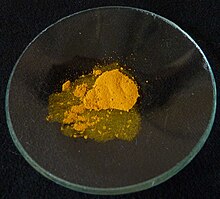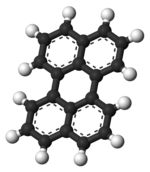
Summary
Perylene or perilene is a polycyclic aromatic hydrocarbon with the chemical formula C20H12, occurring as a brown solid. It or its derivatives may be carcinogenic, and it is considered to be a hazardous pollutant. In cell membrane cytochemistry, perylene is used as a fluorescent lipid probe. It is the parent compound of a class of rylene dyes.
| |||

| |||
| Names | |||
|---|---|---|---|
| Preferred IUPAC name
Perylene[2] | |||
| Other names
peri-Dinaphthalene; Perilene; Dibenz[de,kl]anthracene
| |||
| Identifiers | |||
| |||
3D model (JSmol)
|
| ||
| 1911335 | |||
| ChEBI |
| ||
| ChEMBL |
| ||
| ChemSpider |
| ||
| ECHA InfoCard | 100.005.365 | ||
| EC Number |
| ||
| 104944 | |||
| KEGG |
| ||
PubChem CID
|
| ||
| RTECS number |
| ||
| UNII |
| ||
CompTox Dashboard (EPA)
|
| ||
| |||
| |||
| Properties | |||
| C20H12 | |||
| Molar mass | 252.316 g·mol−1 | ||
| Appearance | Brown solid | ||
| Melting point | 276 to 279 °C (529 to 534 °F; 549 to 552 K) | ||
| -166.8·10−6 cm3/mol | |||
Except where otherwise noted, data are given for materials in their standard state (at 25 °C [77 °F], 100 kPa).
Infobox references
| |||
Reactions edit
Like other polycyclic aromatic compounds, perylene is reduced by alkali metals to give a deeply colored radical anion and a dianion. The diglyme solvates of these salts have been characterized by X-ray crystallography.[3]
Emission edit
Perylene displays blue fluorescence. It is used as a blue-emitting dopant material in OLEDs, either pure or substituted. Perylene can be also used as an organic photoconductor. It has an absorption maximum at 434 nm, and as with all polycyclic aromatic compounds, low water solubility (1.2 x 10−5 mmol/L). Perylene has a molar absorptivity of 38,500 M−1cm−1 at 435.7 nm.
-
Perylene dissolved in dichloromethane exposed to Long Wave UV radiation
-
Perylene dissolved in dichloromethane exposed to Short Wave UV radiation
Structure edit
The perylene molecule consists of two naphthalene molecules connected by a carbon-carbon bond at the 1 and 8 positions on both molecules. All of the carbon atoms in perylene are sp2 hybridized. The structure of perylene has been extensively studied by X-ray crystallography.[4]
Biology edit
Naturally occurring perylene quinones have been identified in lichens Laurera sanguinaria Malme and Graphis haematites Fée. [5]
References edit
- ^ Perylene at Sigma-Aldrich
- ^ International Union of Pure and Applied Chemistry (2014). Nomenclature of Organic Chemistry: IUPAC Recommendations and Preferred Names 2013. The Royal Society of Chemistry. p. 206. doi:10.1039/9781849733069. ISBN 978-0-85404-182-4.
- ^ Näther, Christian; Bock, Hans; Havlas, Zdenek; Hauck, Tim (1998). "Solvent-Shared and Solvent-Separated Ion Multiples of Perylene Radical Anions and Dianions: An Exemplary Case of Alkali Metal Cation Solvation". Organometallics. 17 (21): 4707–4715. doi:10.1021/om970610g.
- ^ Donaldson, D. M.; Robertson, J. M.; White, J. G. (1953). "The crystal and molecular structure of perylene". Proceedings of the Royal Society A. 220 (1142): 311–321. Bibcode:1953RSPSA.220..311D. doi:10.1098/rspa.1953.0189. JSTOR 99329. S2CID 97262226.
- ^ Annick Mathey, Wim Van Roy, Luc Van Vaeck, Gert Eckhardt, Wolfgang Steglich (1994). "In situ analysis of a new perylene quinone in lichens by Fourier-transform laser microprobe mass spectrometry with external source". Rapid Communications in Mass Spectrometry. 8 (1): 46–52. Bibcode:1994RCMS....8...46M. doi:10.1002/rcm.1290080109.
{{cite journal}}: CS1 maint: multiple names: authors list (link)




